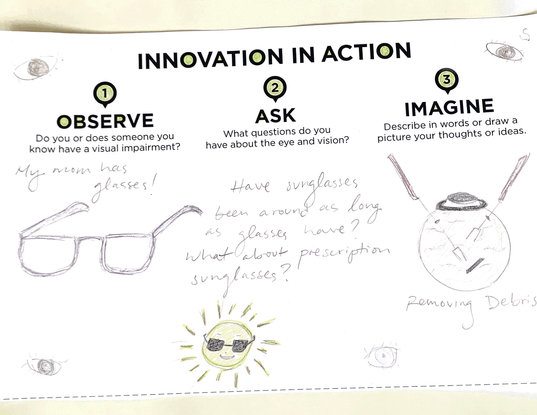Author: Aubrey Minshew, Museum Specialist, Truhlsen - Marmor Museum of the Eye®
When we collect the cards from the “Innovation in Action” drawing table, we usually see a mixture of beautiful eye drawings, questions, and imaginative ideas. As summer comes to a close, let’s take a look at an interesting question about summer’s greatest accessory: sunglasses.
Here is the question we received from an interested visitor (with some excellent summertime drawings):

The question reads, "Have sunglasses been around as long as glasses have? What about prescription sunglasses?" The answer may be surprising to some!
First, we need to establish, what are “sunglasses?” While there are writings about people wearing colored lenses that date back to the 1200s – these weren’t necessarily sunglasses. For this blog, sunglasses are glasses that have been purposely made to protect eyes from the harmful effects of the sun.
A precursor to modern sunglasses can be found in the Americas. Inuit cultures in the arctic regions of Canada, Alaska, and Greenland have long worn slitted goggles to reduce sunlight’s glare and to prevent snow blindness. In order to jump from sunshades to modern sunglasses, we need to look at the history of colored lenses.
In 13th century China, eyeglasses were made with lenses of dark or smoky quartz. It’s believed that these were worn for cosmetic reasons. In the West, colored lenses were advertised for eyeglasses starting in 1571. Eyeglasses with green or blue lenses were advertised as having “great publick utility and benefit” for tired eyes. According to a British advertisement, these prescription lenses were to help improve visual acuity, not to shield the eyes from the sun.

Chinese spectacles with dark quartz lenses.
Moving in to the 1800s, there was actually a fad for spectacles with blue lenses. Augustus J. Pleasonton, who was not a doctor but a retired Army general, published a book in 1876 speculating that the color blue had health benefits. His theory rested on the idea that plants and animals flourished the most in the springtime because that was when the sky was the most blue, and this flawed logic was applied outward to anything blue having health benefits. Even though his claims were debunked by the journal Scientific American the next year, blue spectacles were popular throughout the next few decades.

Blue lenses were touted to have health benefits, but were not specifically designed for sun protection.
Th next step toward modern sunglasses occurs in the 20th century. By this time, industrial workers were being exposed to high heat and extremely bright light while on the job. In 1913, Sir William Crookes published 300 formulas of tinted glass that were ranked by their ability to block heat, ultraviolet (UV) and infrared (IR) light. These formulas were sold to manufacturers to make industrial goggles and protective eyewear.

Colored lenses were surrounded by mesh to protect the eyes of railroad workers.
These special lenses made sunglasses possible. Sunglasses, the way we think about them, were invented in 1929 by a man named Samuel Foster. Foster sold non-prescription eyeglasses with modern protective lenses at his stand on the Boardwalk in Atlantic City, New Jersey. Despite this fashion forward movement, sunglasses were not widespread. Sunglasses only gained mass appeal in 1937, when Ray Ban started manufacturing polarized sunglasses for pilots of the Army Air Corps. One year later, Ray Ban marketed “aviator sunglasses” to the public and they became a very popular fashion trend that are still for sale today. While the style and manufacture of sunglasses continue to change over time, the sunglasses we wear now all descend from these mid-twentieth century inventions.

Left: F.W. Hunter, Army Test Pilot, October 1942 Right: Basic Flight Training, Army Air Corps, 1944. Col. Thomas J. Tredici, MD Collection
Objects from the history of sunglasses and protective eyewear are featured in the “Spectacular Spectacles” special exhibition, on display until Spring 2023.